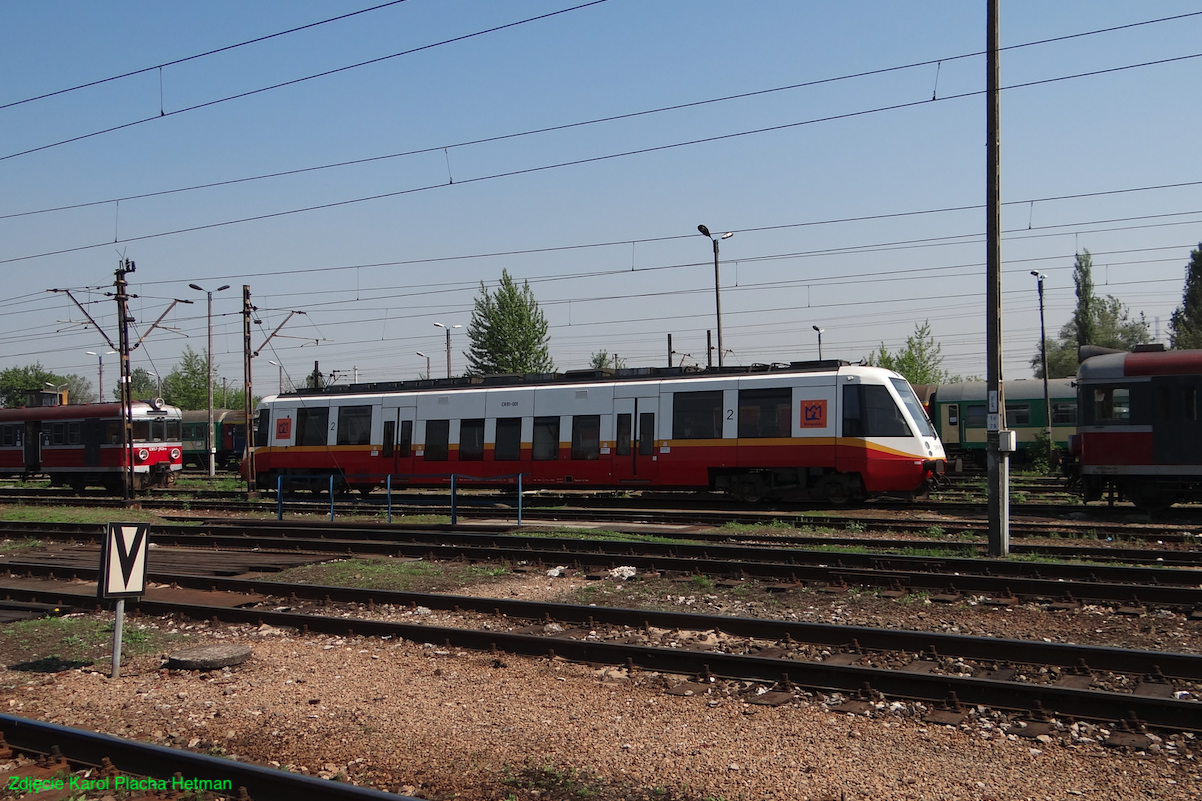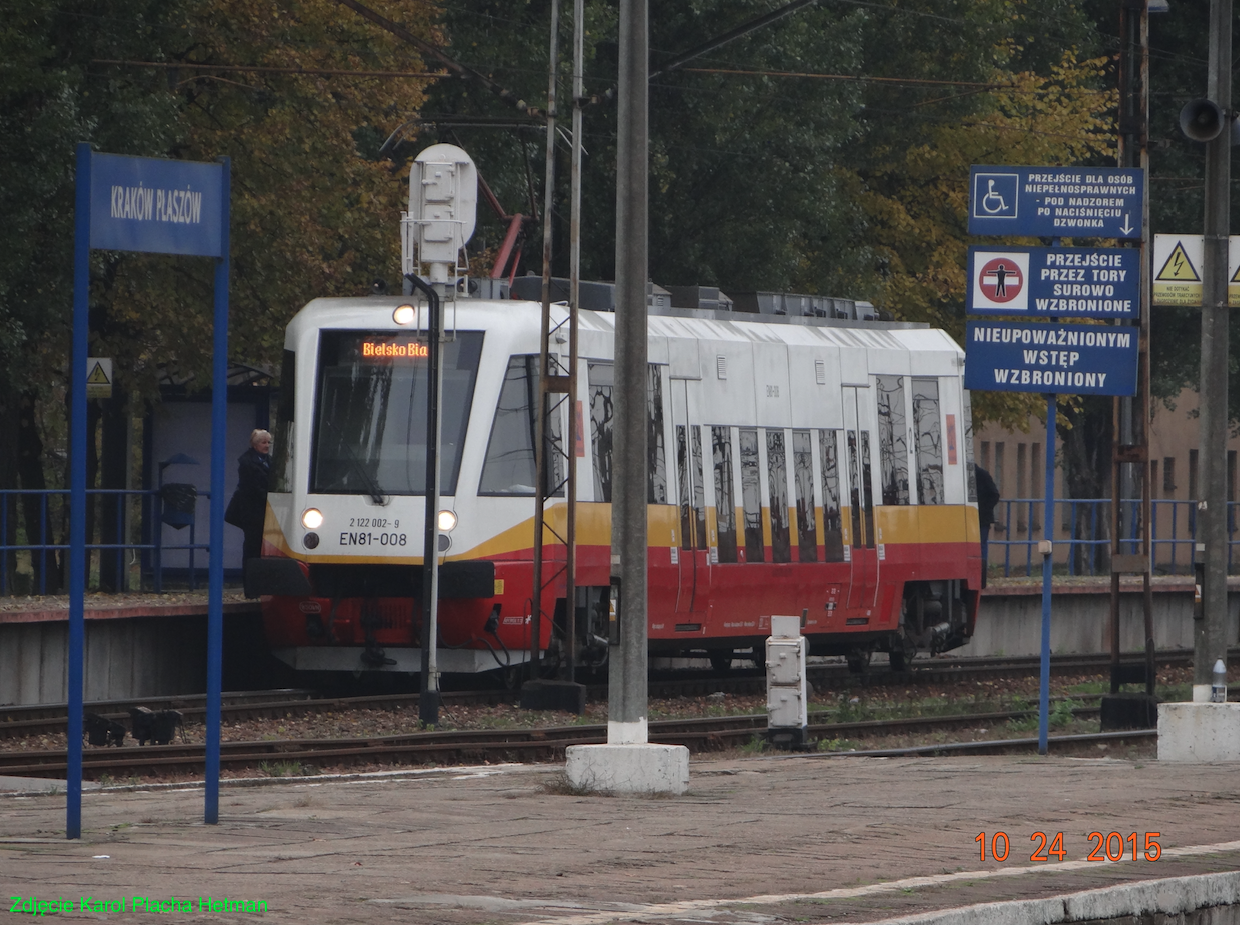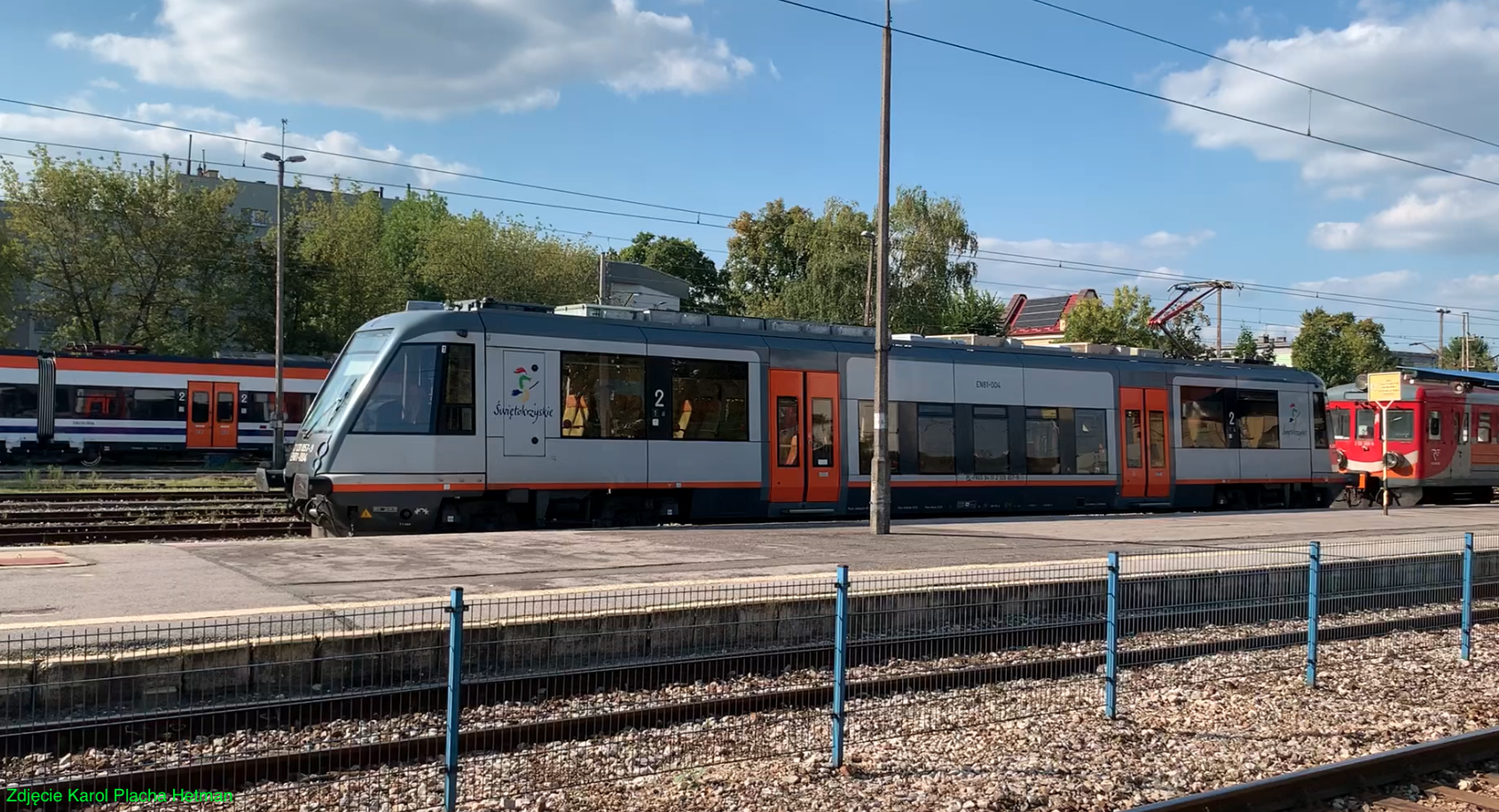Kielce 2023-09-27
PESA EN81 motor wagon.
Electric Motor Car PESA 308B, EN81.
In Poland, we have problems with the naming of single-car electric and combustion vehicles. This is largely due to the period when Freemasonry was joyfully liquidating the Polish Railway. Society was told that it did not need trains, local and regional connections, or railway stations. That we don't need to commute to work, schools or offices. And it would be best if we left Poland. We were told that we were technically, culturally and especially religiously backward. Freemasonry claimed that small rail vehicles would be enough because there were few passengers. But when in 2005, PESA from Bydgoszcz developed a successful 308B vehicle, only 8 copies were ordered. Why? Because the vehicle turned out to be too small for the actual streams of passengers.




PESA 308B is a single-car rail vehicle, and in PKP it has been marked EN81, i.e. Low-Perone Electric. Using the name EMU is a bit exaggerated, because it is not a multi-unit vehicle. Although the wagon can be combined into three-wagon sets. The names used in the railway industry press are; Electric Rail Bus, Electric Rail Bus. According to PKP markings, it is an Independent Motor Wagon, regardless of the drive unit used. The manufacturer PESA named the vehicle; Rail Bus. Nevertheless, using the name EMU is not a mistake, especially since currently rail buses are a marginal part of the rolling stock in Poland.
The Pesa 308B vehicle is a single-car, motor vehicle, powered by 3 kV DC electric traction. The wagon uses a Bo'2' axle system, which means that the vehicle has one driving bogie and one rolling bogie. However, the wagon system is marked as "s", i.e. engine.
When comparing combustion wagons with wagons powered by electric traction, you must know that the operating cost of combustion wagons is 4-5 times higher than that of electric wagons. Therefore, electrifying railway lines is effective. In addition, EMUs have; they have a higher cruising speed, accelerate faster, and have a simpler drive system that is easier to operate.
PESA Bydgoszcz.
Since 1998, PESA Bydgoszcz has been undergoing serious restructuring. In 2001, the plant began to produce diesel wagons from the 214M family. In 2004, the production of an electric multiple unit (EMU) for the Warsaw Commuter Railway, marked EN95, began. In 2005, the first electric wagon was produced in Bydgoszcz. Experience gained in the design of previous railcars was used. Bogies and seats installed in type 214M trains were used. The fronts of the trains were adopted from the EN95 EMU. The floor was lowered in the section between the trolleys.
History of EN81.
The PESA 308B wagon received the EN81 marking at PKP. It was produced in 2005 and 2007. A total of 8 copies were built. The wagon is still in the manufacturer's offer, but no order has been received since 2007. The wagons were produced for the Świętokrzyskie and Lesser Poland Voivodeships. The wagons were intended for electrified routes with very low passenger traffic.
In 2005, a decision was made in Małopolska to modernize and electrify the important railway line No. 118 Kraków Główny - Balice Airport. But there was no appropriate rolling stock. On December 30, 2004, the Lesser Poland Voivodeship signed a contract with PESA for the supply of 2 EN81 units for the Małopolski Zakład Przewozy Regionalnych. These vehicles were ceremoniously presented at the Kraków Główny station on September 30, 2005, and hit the trails; Wieliczka - Kraków Główny - Krzeszowice and Skawina - Kraków Płaszów - Kraków Główny - Krzeszowice. The route to Balice Airport was not yet electrified and was operated by combustion vehicles.
In November 2005, the first two EN81 vehicles for Świętokrzyski Zakład Przewozy Regionalnych were presented in Kielce. The vehicles were sent to routes to Skarżysko Kamienna, Ostrowiec Świętokrzyski and Sędziszów.
In 2014, Małopolska ended the operation of its two EN81. Already in 2016, the Małopolska Voivodeship decided to stop using EN81 vehicles. The vehicles were not sent for P4 level repairs. In 2018, the vehicles were put up for sale. In January 2021, Piotr Mieczkowski's Rail Vehicle Service became the owner of both units.
EN81 construction.
EN81 is a single-compartment motor wagon, powered by 3 kV DC traction. The wagon is adapted to work in multiple traction. Three EN81 type wagons can be combined into one set, without the possibility of passing between wagons while the train is running. One ordinary passenger carriage can also be attached to the EN81.
Two doors and 11 large windows were installed in the side wall of the vehicle. The vehicle is symmetrical. The front part of the vehicle is narrowed. The front of the vehicle is equipped with a large window, in the upper part of which there is a display with information about the destination station. The window is equipped with one large windshield wiper. There is a third white spotlight above the window. Below the window there are white and red halogen lights, a screw coupling, pneumatic and electric cables and bumpers.
Entrance to the carriage is provided by two pairs of double-leaf doors that open automatically. The doors are of the spring-sliding type. The door clearance is 1.30 m. The entrance threshold is at a height of 0.80 m, from the rail head. At lower platforms, an additional step is extended from the carriage base. Inside the carriage, above the carriages, the floor is higher and there are two steps leading to it. The floor is at a height of 1.29 m from the rail head.
The carriage holds 140 passengers. Passengers have 60 seats at their disposal. One toilet in a closed system was installed in the central part. There are also two places for wheelchairs in the carriage. The vehicle is equipped with a visual information system, monitoring and air conditioning.
At both ends of the train there are the same driver's cabins, separated from the passenger compartment by glass doors. The vehicle is designed to be operated by one person (mechanic) plus a conductor. The mechanic has a control panel in front of him, equipped with liquid crystal screens and good visibility through the windshield. Cabin "A" is located next to the driving bogie, and cabin "B" is located next to the rolling bogie, next to the pantograph. The high-voltage cabinet was placed next to cabin "A". The wagon is equipped with two bogies. The drive carriage is type 22MNa. The rolling carriage is type 22MNb. Both strollers were used for braking and were equipped with disc brakes. The drive trolley is equipped with two asynchronous motors type DKLBZ0910-4A, manufactured by VEM Sachsenwerk. The transmission of rotational motion from the engines is carried out by SZH 495 gearboxes, which are manufactured by Voith. Each electric motor, with a power of 280 kW, is powered by one FT-300-3K transistor inverter, which is manufactured by Medcom. The drive system allows for an acceleration of 0.65 m/s2, up to a speed of 25 km/h. The vehicle has a maximum speed of 130 km/h, and the design speed is as much as 200 km/h.
One half current collector, type DSA200-PKP, manufactured by Stemmann, was installed on the roof of the wagon. The pantograph is placed above the rolling carriage. The length of the glider is 2.03 m.
During operation, some vehicles received new compressors, new air conditioning and new seats. The inverters caused the most problems for the mechanics.
Data T-T EN81:
Length 26.53 m. Width 2.83 m. Height 4.01 m. Wheel diameter 0.84 m. Weight 53,000 kg. Track gauge 1,435 mm. Engine type DKLBZ0910-4A, power 2 x 280 kW. Continuous power 560 kW. Acceleration 0.6-0.8 m/s2. Traveling speed 130 km/h. Maximum speed 200 km/h. Disc brakes and Electrodynamic braking. Entrance to the wagon at 0.80 m from the rail head. The carriage has 60 seats. There will be room for 140 passengers on board.
Written by Karol Placha Hetman
